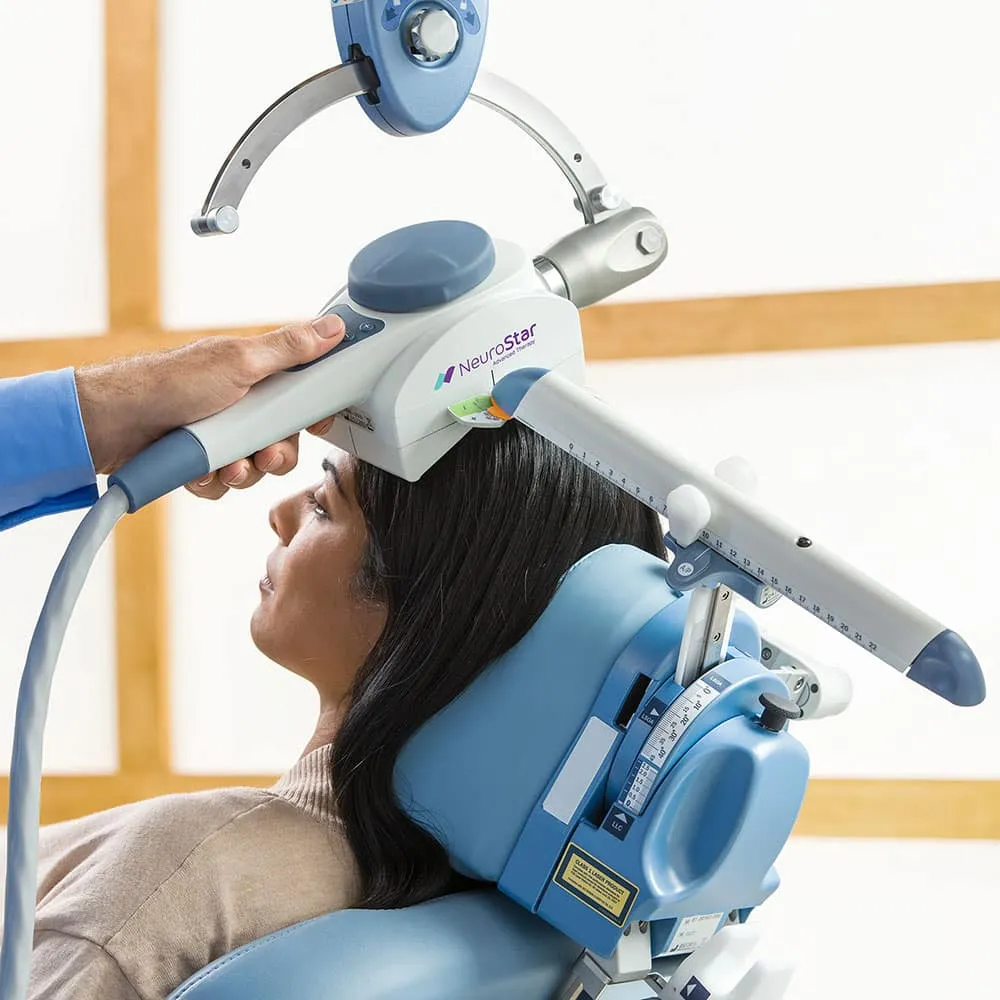What is TMS Therapy?

COVID-19 is changing the way we live. Online instruction, video chatting and conferencing, and food delivery have been around for a long time, but never on this scale. Social Distancing is the new normal. For those of us that have experienced depression, social distancing isn’t unfamiliar. In fact, social distancing is a common behavior for those battling depression. But with cutting-edge technology, such as TMS, there is hope to break this reclusive tendency. Transcranial Magnetic Stimulation (TMS) provides an effective, non-medication alternative to beat depression
TMS therapy has also shown signs of effectiveness with Bi-Polar Disorder, PTSD, Pediatric Depression, Anxiety & OCD. It uses magnetic technology–similar in strength to an MRI machine–to stimulate underactive brain cells in the mood control center. This magnetic stimulation helps restore certain neurochemicals back to normal levels. These neurochemicals are the ones most commonly associated with happiness: norepinephrine, dopamine and serotonin. For those not getting depression relief from antidepressant medications, TMS therapy has the potential to provide a promising solution.
Saying TMS is a non-invasive treatment means that the technology is placed comfortably on the outside of your body, specifically your scalp. This also means that TMS patients have the leisure to drive themselves to and from appointments safely, unlike with surgical procedures.
TMS has fewer side-effects than standard drug therapy (a.k.a. antidepressants). The intended destination of an antidepressant is the brain. In a perfect world, all of that antidepressant would go straight to your brain. But, it doesn’t. Why?

Because antidepressants come in a pill form. You ingest this pill, which then sits in your stomach, is broken down over time, and is absorbed into your bloodstream. Your arteries and veins, which carry your blood, cover your entire body. This means the antidepressant is distributed throughout your entire body, leading to unwanted side-effects such as insomnia, drowsiness, weight gain, dry mouth, fatigue, nausea, and numb feelings. Our vascular system isn’t the best distribution strategy in terms of treatment accuracy. The delivery system for TMS is more accurate and precise at targeting depression.
What would a course of action look like if you were to decide to try TMS?
Before you decide on TMS therapy, schedule a free consultation with a TMS provider. In our practice, we help decide if TMS is a good fit for you at this first consultation. We also gather the information needed to determine if your insurance will cover the treatment. We will do all the leg work, so you don’t have to deal with the insurance-coverage headache. After the consultation, we schedule your first appointment.
Your first session is called a “mapping” treatment. This takes about an hour to an hour-and-a-half and will be the longest of all your appointments. During this “mapping” session, as you sit in a reclining chair, your TMS physician will perform a series of tests to locate your motor strip, an area of the brain that controls muscle movement of your body. We also establish the correct magnetic strength to elicit a twitch from your right hand, specifically your thumb and forefinger. Finding the location of the motor strip in your brain allows us to find the part of your brain we need to stimulate, the Dorsal Lateral Prefrontal Cortex (or DLPC). The DLPC is the “side-door entrance” to the mood circuit of your brain. When the DLPC is magnetically stimulated, the brain cells emit “happy” and natural petrochemicals. Finally, the computer verifies the settings and the coil is moved 5.5 cm forward to target the Dorsal Lateral Prefrontal Cortex. This process allows us to customize your treatment and find the optimal position on your head for the electromagnetic coil.
Fun fact: Anatomically, the DLPC is on average 5.5 cm in front of the motor strip. Knowing this allows us to use your motor strip to find the ‘home address’ of your DLPC.
The rest of your appointments in subsequent weeks will be much simpler. At your appointment time you will be shown to the TMS Therapy room where you will again sit in the reclining chair and put on the ear plugs provided to mute the clicking sounds emitted by the TMS machine. Your TMS technician will place the magnetic coil in the exact position determined by the coordinates identified in your mapping session, and you can relax as your treatment begins. You may feel a tapping on your forehead or scalp during the therapy as 3,000 magnetic pulses are typically delivered over 19 minutes. A mild to moderate headache is the most commonly reported side effect after a therapy session.
Each person’s TMS experience is slightly different in terms of response time. Some patients will feel the benefit almost immediately, while others won’t feel the benefit until the end of the 36-treatment series. Most wait for what seems to be a cumulative effect and begin to feel better slowly after the first couple of weeks. Some patients describe a ‘dip’ in their treatment before experiencing more significant improvement.
While everyone’s experiences with treatment are slightly different, the majority of patients will have the same outcome: a significant decrease and/or elimination of depressive symptoms. In our clinic 84% of TMS patients experience this outcome. A 12-month study followed a group of individuals who had this positive outcome and found that 70% of them sustained the positive benefits for at least a year. Because TMS benefits are statistically significant and the treatment itself is safe, TMS was able to earn the FDA-Approved badge, and coverage by major insurances.
After completing your prescribed number of TMS Therapy sessions with us, usually five days a week for about 7 weeks, you will be given a free session with Dr. Walter Griffith to discuss your outcome. We like to schedule a second follow-up typically one to two months later to monitor how you’re doing. We also offer TMS booster treatments to help sustain your positive TMS outcome. This is not a requirement, but it augments the formal 36-treatment series. Some people have found TMS booster treatments helpful in maintaining their progress if they begin experiencing symptoms of depression a significant period of time after the initial course of treatment. Be sure to discuss this option with your psychiatrist if you believe you might benefit.
WE HAVE SEEN TMS THERAPY HELP SO MANY PEOPLE WHO HAVE LIVED WITH DEPRESSION THAT WE WANT TO MAKE IT AS EASY AS POSSIBLE FOR YOU TO BENEFIT AS WELL. THERE IS HOPE.
If you think you might benefit from TMS or would like to find out if TMS is right for you, please contact us for a consultation:
Request an Appointment
Our care team would love to hear from you! We want to see our patients get healthy.
This is our top priority.
- 727-577-1203
- Free Consult







